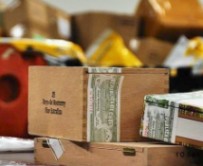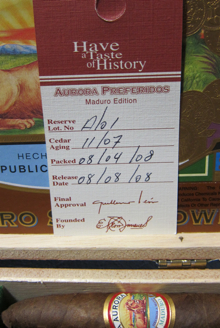Stogie Tips: Dealing with Dreaded Tobacco Beetles
14 Dec 2010
Recently, a single batch of cigars caused three different Stogie Guys’ humidors to show signs of the dreaded cigar beetle. The culprits were caught quickly, but the incident provides a good learning opportunity to talk about what to do when you notice beetle holes (pictured below) in your cigars.
Isolate
Immediately upon the discovery of signs of tobacco beetles, it is critical to stop them from spreading. This means not only removing cigars with beetle holes, but all others that may have beetle eggs in them. First you should inspect all your other cigars for similar holes.
If you see a beetle hole in one cigar, then that means the beetle has hatched and already moved on, likely to another cigar. In a small humidor, particularly where the cigars are not kept in cellophane, this means isolating the entire contents of the humidor. In a larger cabinet, if the infested cigar is in a closed box, I’d recommend isolating the cigars in that box, while keeping an eye on the other cigars in the humidor.
Decontaminate
Cigars with obvious holes should probably be tossed, because even though they may be dead after the decontamination process, smoking a cigar that has beetle eggs in it isn’t a pleasant experience. For all those cigars you are suspicious of, freeze them to make sure any eggs don’t hatch.
To do this, first put all the cigars in a ziplock freezer bag, then in a second ziplock, and carefully remove as much air from the bags as possible before sealing. Then place the bags into a refrigerator for 24 to 48 hours. Next, move them to the freezer for at least 48 hours, after which you again place the cigars into the refrigerator for two days. The stints in the fridge will make sure that the cigars don’t crack from too sudden of a temperature change or generate condensation, and the freezer will kill any beetle eggs.
Prevent
Once you’ve dealt with the contamination and made sure all your cigars are egg-free, it’s worth examining how they got there to begin with. High temperatures, particularly those above 75 degrees Fahrenheit, are conducive to eggs hatching, so keeping your humidors below 70 degrees is key. Personally, I find that 65 degrees and 65% humidity is ideal. But the real way to prevent beetles from wreaking havoc on your treasured cigars is make sure that cigar beetles aren’t present in your cigars before they go into your humidor.
Some manufacturers freeze their cigars, but others don’t. Getting information on who does and doesn’t can be hard to come by. (Plus, depending on how retailers keep their cigars, it is always possible for those that are frozen to become infested.) That means you have to be vigilant about what goes into your humidor. The best way to do this is to freeze every cigar before it goes into your humidor.
For those who feel this approach is overkill (including me), carefully monitor your existing collection and freeze new cigars that you may be suspicious of. Often, I keep new cigars separated for a month before they get mixed with my other cigars. And since high temperatures cause beetle outbreaks, I am far more likely to freeze cigars that have been shipped to me during the summer, when the temperature in a UPS truck is likely to be way above 75 degrees.
No matter what procedures you decide to put in place, knowing what causes cigar beetles and how you can minimize the risk of an outbreak is vital. Being vigilant will protect your cigars, and if a cigar beetle does sneak by, taking the steps above will minimize the damage they cause and protect your valuable cigars.
photo credit: Stogie Guys

 Long before his Decade, Edge, Old World Reserve, Vintage blends, and many others, there was Indian Tabac—Rocky’s original brand made in DanlÃ, Honduras by Nestor Plasencia. “This cigar line was created in the 1990s with the true cigar aficionado in mind,†according to Rocky’s
Long before his Decade, Edge, Old World Reserve, Vintage blends, and many others, there was Indian Tabac—Rocky’s original brand made in DanlÃ, Honduras by Nestor Plasencia. “This cigar line was created in the 1990s with the true cigar aficionado in mind,†according to Rocky’s 

 1) U.S. Customs officials seized 30,000 Cuban cigars when the illegal smokes arrived at Chicago’s O’Hare airport this week. “The flood of the popular contraband is the biggest seen at the Customs and Border Protection’s Chicago field office, which typically seizes 10 to 12 cigars a week at the O’Hare international mail facility,†reports the
1) U.S. Customs officials seized 30,000 Cuban cigars when the illegal smokes arrived at Chicago’s O’Hare airport this week. “The flood of the popular contraband is the biggest seen at the Customs and Border Protection’s Chicago field office, which typically seizes 10 to 12 cigars a week at the O’Hare international mail facility,†reports the  Chances are you’ve got at least one cigar enthusiast on your shopping list. Be it a father, an uncle, a friend, or a co-worker, it’s important to keep in mind that tastes in cigars vary widely. Some people are averse to specific brands based on past experiences, some only like very mild or very strong cigars, some are maduro smokers or Cuban snobs, and some are just plain picky. Whatever the case, here are seven simple rules that will help you choose the best gift for your favorite cigar smoker:
Chances are you’ve got at least one cigar enthusiast on your shopping list. Be it a father, an uncle, a friend, or a co-worker, it’s important to keep in mind that tastes in cigars vary widely. Some people are averse to specific brands based on past experiences, some only like very mild or very strong cigars, some are maduro smokers or Cuban snobs, and some are just plain picky. Whatever the case, here are seven simple rules that will help you choose the best gift for your favorite cigar smoker: And when these terms appear on a box of a cigars or in a cigar catalog, it’s often hard to hard to separate the marketing hyperbole from the facts. Does the handmade cigar industry need better labeling? If so, who should decide what those standards are and how they might be enforced?
And when these terms appear on a box of a cigars or in a cigar catalog, it’s often hard to hard to separate the marketing hyperbole from the facts. Does the handmade cigar industry need better labeling? If so, who should decide what those standards are and how they might be enforced? Patrick Ashby
Co-Founder & Editor in Chief
Patrick Ashby
Co-Founder & Editor in Chief Patrick Semmens
Co-Founder & Publisher
Patrick Semmens
Co-Founder & Publisher George Edmonson
Tampa Bureau Chief
George Edmonson
Tampa Bureau Chief